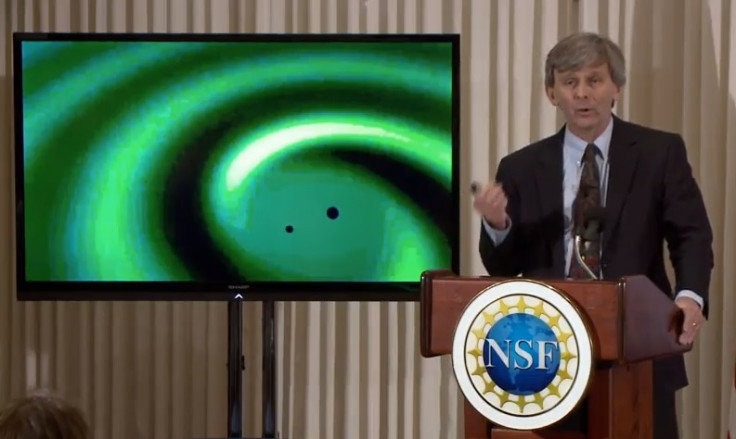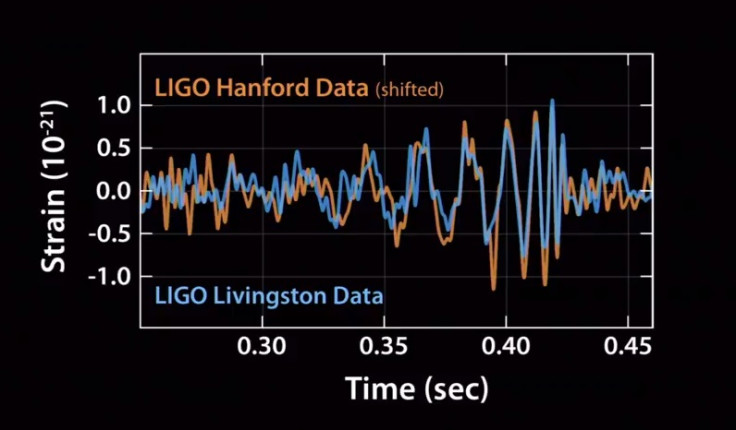Gravitational waves discovered: LIGO announce detection of ripples in spacetime

Gravitational waves have been detected for the first time, scientists have announced. At a press conference at the National Science Foundation, a team from Caltech, MIT and the Laser Interferometer Gravitational-Wave Observatory (LIGO) Scientific Collaboration (LSC) said they had discovered ripples in spacetime from a binary black hole merger.
David Reitze, executive director of LIGO, said: "We have detected gravitational waves. We did it. I am so pleased to be able to tell you that." He said the gravitational waves came from two colliding black holes both about 30 times the mass of the sun.

The signal detected had a very specific characteristic, he said. "As time went forward the frequency went up. It was exactly what you would expect from Einstein's theory of general relativity from black holes spiralling together."
He said they spent months and months checking and then re-checking what they saw until coming to the conclusion about what they had found. "What's really exciting is what comes next," he said.
The black holes collided 1.3 billion years ago – when life on earth was just beginning to spread.
France Cordova, director of the National Science Foundation, who introduced the presentation, said the discovery opens "a new observational window would let us see our universe in an entirely new way".
Of the discovery, renowned physicist Stephen Hawking said: "These amazing observations are the confirmation of a lot of theoretical work, including Einstein's general theory of relativity, which predicts gravitational waves."

What are gravitational waves?
Gravitational waves are distortions, or 'ripples', in the fabric of space-time. Einstein said space-time is not a void but a four-dimensional fabric that can change as objects move through it. He said massive accelerating objects, such as black holes and neutron stars, would disrupt space-time so that waves of distorted space would radiate from the source. These ripples were predicted to travel at the speed of light and contain information about where they came from. However, by the time they reached Earth they would be so tiny they would be neigh-impossible to detect – until now.
The gravitational wave were detected on 14 September last year at both the twin Laser Interferometer Gravitational-wave Observatory (LIGO) detectors, located in Livingston, Louisiana, and Hanford, Washington.
LIGO scientist Ed Daw, from the University of Sheffield, said a discovery like this come along maybe once every 30 years. "A measure of its significance is that even the source of the wave – two black holes in close orbit, each tens of times heavier than the sun, which then collide violently, has never been observed before, and could not have been observed by any other method," he said.
The findings will be published in the journal Physical Review Letters.
Kip Thorne, from Caltech said: "LIGO opens a new window on the universe. Each time a new window opens up, there have been big surprises. LIGO is just the beginning. Over the next decade or two we will have four gravitational wave windows open to the universe."
He added that they expect to detect even more as LIGO become more sensitive: "We ought to see some more over the coming year. LIGO is at a third of its ultimate design sensitivity. That means you will be able to see three times farther in the universe... after this tweaking, the rate will be 30 times higher than it is now."
But will this bring us closer to being able to time travel? Thorne said: "I think it brings us a much deeper understanding ... of how warp space time behaves when it is extremely warped. When it is in the nonlinear regime.
"I don't' think it's going to bring us any closer to being able to do time travel. I wish it would. This is a different direction to where LIGO is going."
© Copyright IBTimes 2025. All rights reserved.






















